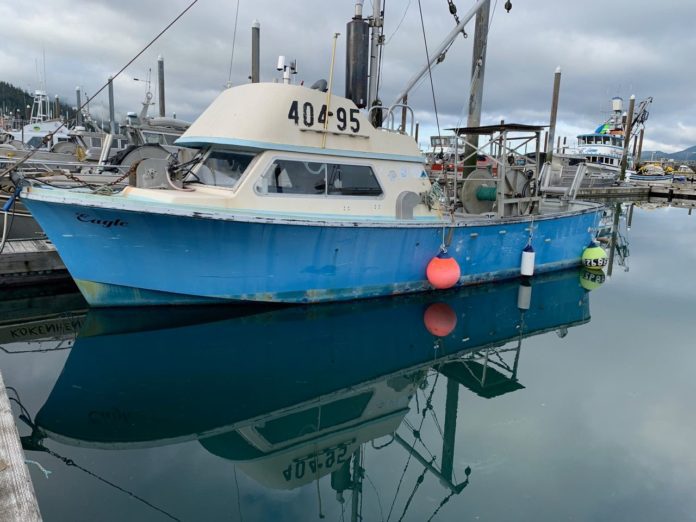
Watching eagles dive from tall trees across from our home on Odiak Slough to catch pink salmon exposed at low tide reminded me of the days of yore when I was seining with Dick Renner on his new boat named the Dragonfly.
Dick and Carl Arvidson had sister ships built in Seattle. Carl named his the “Eagle,” and when they were transiting through the locks out of Lake Washington, Dick was in the lead. Evidently there was confusion for Carl, as over a loudspeaker, he heard an urgent announcement: “Eagle! Eagle! What are you going to do?”
Dick and Carl were good friends and had both begun fishing in the Cordova area at a young age. Dick loved to tell the story about the maiden voyage of their matching boats. It was always good for a laugh.
The Eagle still sits in the Cordova boat harbor and is used in set net operations by the Kritchens on the other side of the Sound. Seeing it reminded me of another eagle story witnessed from Renner’s Dragonfly.
We were banging out sets along the outer edge of Chenega Island, and I was in the skiff towing the end of the seine right up to the beach. The island rose in a steep cliff wooded with tall trees. The water was so clear and deep you could put the bow of the skiff against the rock outcroppings and literally watch schools of fish leading into the seine.
In fact, Dick, a veteran skiff man, would often ask how many fish we had in set after we closed up. I wasn’t very good at estimating.
While drifting offshore and waiting for our next turn, we watched to see how other boats were doing, and also had a chance to study the remarkable scene.
We noticed an eagle nest in a tall tree several hundred feet above the water, and watched as an eagle would drop food on the edge of the nest, and then depart to perch on a tall barren tree nearby.
Through binoculars, at first we could see two immature eagles scuffling over the food as it arrived, but it wasn’t too long before there was only one. Survival of the fittest is an acknowledged method of eagle “child” rearing.
We spent much of the season at Chenega and witnessed the gradual maturation of this eaglet. Eventually it was standing on the edge of the nest in splotchy brown and white plumage waiting for its next meal to arrive and stretching its wings.
We began watching it flap more often and more vigorously and began making wagers on when it would go for it.
Clearly there was no such thing as ground school before its first flight.
Luckily it was a clear sunny day and we just happened to be in between sets when the young eagle launched its maiden flight.
Spreading its wings and leaping, it came screaming down at an alarming speed, and hit the water head-first with a spectacular splash.
Wow.
We grabbed the binoculars to see it had survived.
Indeed, it had, and to our amazement was using its wings to paddle back to shore.
The next morning we started our 16 hauls a day routine in the same spot, and when the sun was bright enough, we cheered to see none other than the same eagle perched on the edge of same nest, with his mother off on her spot, looking on.
Somehow that eagle had clawed through the timber and climbed back up the right tree.
For several days, the mother brought him food, and then we were lucky to witness flight two.
Preflight was exactly the same flapping of wings, and then came jumping into space.
We held our breath as it again accelerated at high speed, but this time right before it was going to crash it extended its wings, and using the momentum to soar all the way up the cliff side and knock his mother off her perch.
The screech of victory that could be heard all the way to our boat.
It was a highlight of the whole season.
“Eagle Eagle, what are you going to do?”
Indeed.














